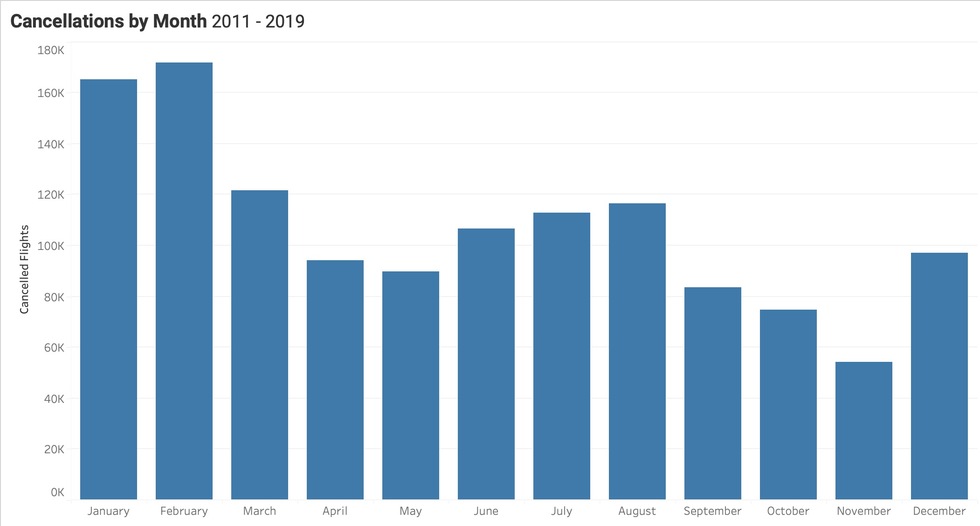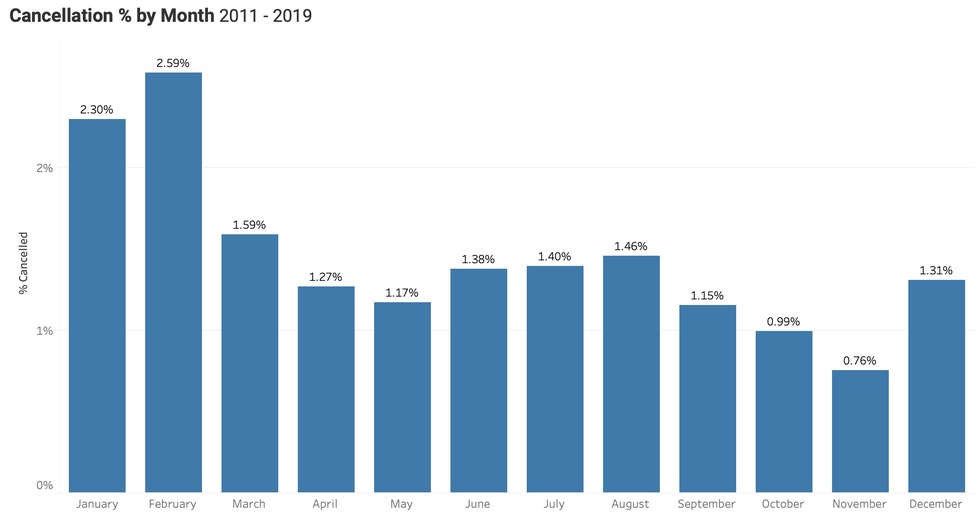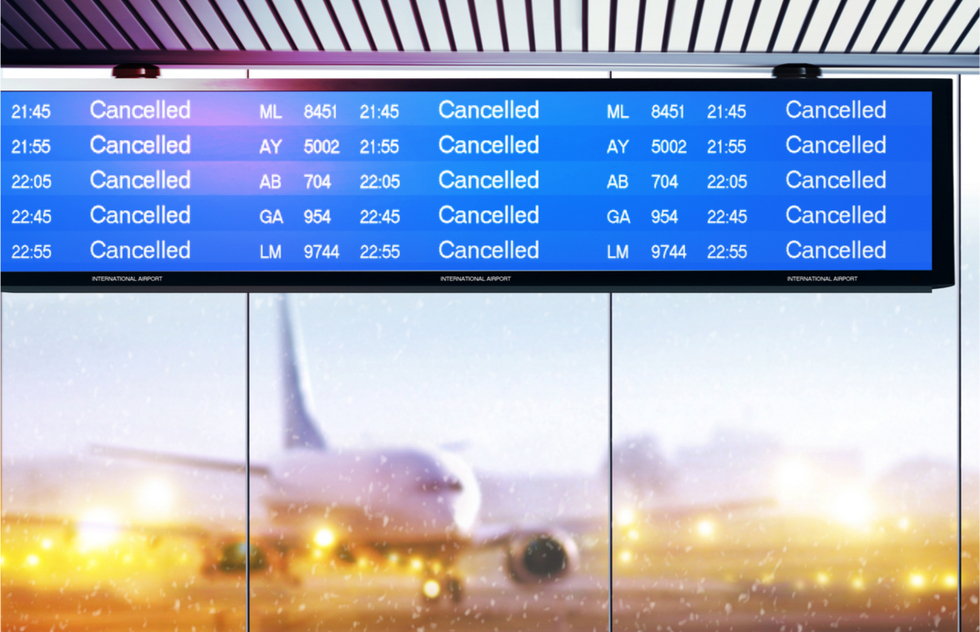The answer to the headline is easy: Use the Tooth Fairy or Santa Claus as your travel agent.
The truth is there's always the chance that a flight will be canceled. We're seeing extreme weather patterns in this era of climate change, and the airline industry has a propensity for staffing shortages.
But it's also true that if you are strategic about your initial flight purchase, you can decrease your chances of getting hit with a canceled flight.
To explain what you should do, I turned to a source that knows a lot about delays and cancellations: FlightAware, a site that tracks flights around the globe. I spoke with Kathleen Bangs, a former commercial pilot who is now a spokesperson for the company. Her advice, added to mine, will help put you in a better position if your flight does get canceled.
Fly At the Right Time
That rule covers both hours of the day and the season of the year.
Though it's painful to get up before dawn, the first flights each day are the most likely to leave on time and without issue, says Bang, because the planes they use have been parked at the airport overnight and crews will also have overnighted in the area.
Later in the day, the majority of flights will use airplanes, pilots, and flight attendants that must travel from other airports—and any of them could be delayed. "It's a complex jigsaw puzzle," says Bangs. "If there's a weather situation in the region your plane or crew is coming from, your flight could be delayed or canceled . . . even if the day is perfect at your airport."
The calendar matters as much as the clock. Due mostly to weather events, certain months tend to have more delays and cancellations than others.
Bangs and her team prepared the following charts showing which months are worst for cancellations for domestic travel in the United States. (We're concentrating on the period between 2011 and 2019 because pandemic-era figures have been skewed by other factors that don't appear in a normal year.)
The first chart represents the number of cancellations per month while the second one is for the percentage of flights that were canceled.


As you can see, January and February have the most cancellations, by a good margin. Summer storms make August and July the year's second set of most problematic months to fly.
That being said, if you look at the second chart, you'll see that even during periods of higher cancellations, the rate never exceeds 3% of all flights—that's not too bad, and it's worth remembering that even when things look bad in the headlines, most flights still reach their destinations as planned.
Avoid Stopovers
The simple rule: The fewer times you take off and land, chances are lower for something to go wrong, says Bangs.
We recently published a very helpful article about how to find nonstop flights when searching for routes between city pairs. Use it to plan itineraries that don't require stops. Sometimes nonstop airfare costs a little more, but the expense can be worth it to avoid the potential for hassle.
Choose a Hub Over a Secondary Airport
If you have a choice between airports, choose the one with more traffic, especially if any airline uses it as a hub where many passengers change planes.
It's a numbers game, says Bang. "You want to connect through or fly from a hub, because you’ll have a much better chance of getting a new flight if your first one gets canceled," she says. "Hubs just have more flights. To give an example: If I lived between Chicago and Milwaukee, I would always fly out of and into Chicago O’Hare because you know they’ll get operations moving again when things go wrong. There will be so many more options for flights [than you'd get at Milwaukee's airport]."
Buy a Second Ticket on Southwest
This is a sneaky tip from Bangs that I'd never heard of before.
Unlike most carriers, Southwest allows passengers to cancel up to 10 minutes before their flight for a reusable travel credit. So when Bangs really has to be somewhere, she will sometimes book a first flight on another carrier plus a backup flight on Southwest just in case something goes wrong with her first itinerary. If all goes well, she cancels the Southwest flight and uses the credit later.
Book Directly with the Airline (When You Can)
This tip comes from me. If your flight is canceled, you will be able to get help directly from the airline. If you buy a ticket from a third party travel seller, you have to go back to them, which could lose you valuable time when you're scrambling to re-book a flight.
Besides, if your flight is canceled while you're at the airport, it's far easier to find an airline employee than to get a website's customer service rep on the phone.
You should also get into the habit of traveling with carry-on luggage rather than checking a bag. When flights are canceled, passengers with carry-ons are often able to pivot faster.
Steps to Take if Your Flight Is Canceled
When cancellations do occur, know that your airline will automatically rebook you on another flight (except American Airlines, which could dump you and give you a refund after just four hours of delays). Whether that replacement flight is anytime soon, though, is an open question.
In some cases, flights to certain destinations only happen once a day or a few times per week. Some airlines work with rival carriers to get you to your destination in a timely fashion, but not all are willing to do it.
No-frills carriers such as Frontier Airlines and Spirit Airlines do not have these types of agreements in place with other carriers, and in September of 2021, American Airlines quietly changed its contract of carriage to eliminate the promise that it would book passengers on the next available flight with open seats. Now, American only gives a refund or will only book you on the next American flight, which could take time.
When your flight is canceled, you must be proactive. If you're at the airport when you get canceled, immediately go to the service desk to talk with an agent so you'll have a space in line. While you're waiting, go online to see if you've been rescheduled. Downloading your airline's app in advance of a trip can be a good way to keep track of these changes.
Even if you're still in line, you should also try to contact the airline by phone, just in case—though that can be an exercise in frustration now that airlines are understaffing their call centers. If you normally use the English-language service, you might be able to snag a shorter wait by selecting the Spanish language option (don't worry, your eventual operator will be bilingual) or finding an international number for the airline and calling that. On most phone plans, the cost won't be much more.
If you're assigned a new flight, before you accept it go to FlightAware's site to see where the new plane is coming from. If it's coming from another airport hit with weather issues, you could still be in hot water, and you'll want to find another option. You should be able to figure out the current situation at airports by checking FlightAware's Misery Map for current conditions or looking at weather apps for info on storms and wind.
Bangs hopes that the traveling public will also look at the good side of air travel. "Since 2009, there’s not been a fatal crash of a U.S. airline. The traveling public takes this for granted, but it’s one of the best safety records in the history for mankind when it comes to transportation," she says. "There was a time when crashes happened all the time. That time is in the past, and I, for one, am really grateful."






